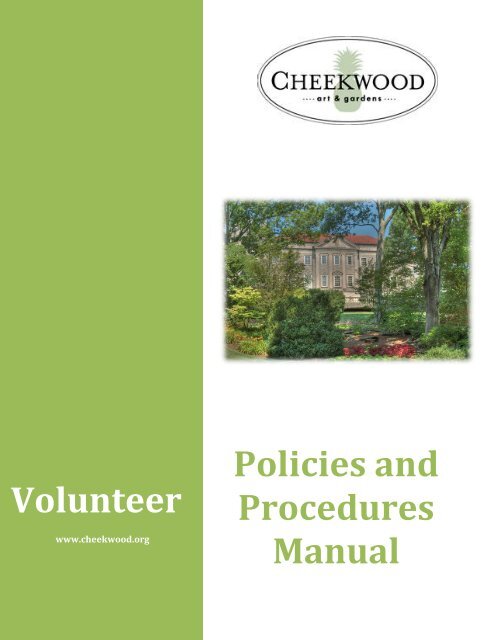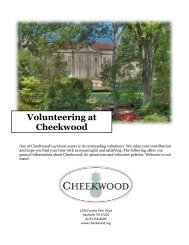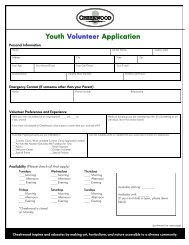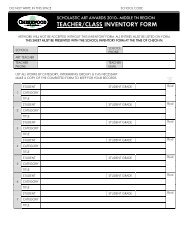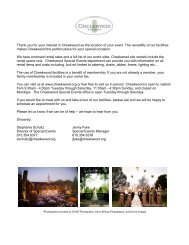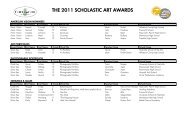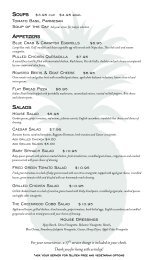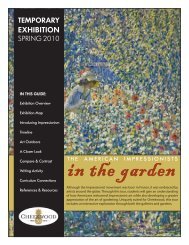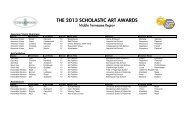Policies and Procedures Manual Volunteer - Cheekwood Botanical ...
Policies and Procedures Manual Volunteer - Cheekwood Botanical ...
Policies and Procedures Manual Volunteer - Cheekwood Botanical ...
You also want an ePaper? Increase the reach of your titles
YUMPU automatically turns print PDFs into web optimized ePapers that Google loves.
Polic<strong>Policies</strong> <strong>and</strong><strong>Volunteer</strong>Contentswww.cheekwood.orgGeneral Information<strong>Procedures</strong><strong>Manual</strong>
CONTENTS<strong>Cheekwood</strong> Mission, Values <strong>and</strong> Vision …………………………………….…….…. 3Welcome to <strong>Cheekwood</strong> /A History of <strong>Cheekwood</strong> ………………………..…… 4<strong>Cheekwood</strong> Collections/The Museum of Art ……………………………….…….. 8The <strong>Botanical</strong> Garden…………………………………………………………………..……. 9Bryant Fleming <strong>and</strong> Philip Kerrigan, Jr…………………………………….…………. 11Carell Woodl<strong>and</strong> Sculpture Trail ……………………………………………………….. 12<strong>Cheekwood</strong> Services ………………………………………………………………………... 13<strong>Volunteer</strong> <strong>Policies</strong> <strong>and</strong> <strong>Procedures</strong> …………………………………………………… 14Professional Practices ………………………………………………………………………. 17<strong>Volunteer</strong> Opportunities ………………………………………………………………….. 19Safety <strong>Procedures</strong> ……………………………………………………………………………. 20General Information ………………………………………………………………………… 24Directions to <strong>Cheekwood</strong> ……………………………………………………………….... 25
<strong>Cheekwood</strong> Mission, Values <strong>and</strong> VisionMission<strong>Cheekwood</strong> is a 55-acre botanical garden <strong>and</strong> art museum located on the historic Cheekestate. <strong>Cheekwood</strong> exists to celebrate <strong>and</strong> preserve its l<strong>and</strong>scape, buildings, art <strong>and</strong> botanicalcollections <strong>and</strong> through these unique means, provide an inspiring place for visitors to exploretheir connections with art, nature <strong>and</strong> the environment.Values-Preservation of our l<strong>and</strong>scape, structures, art <strong>and</strong> botanical collections.-Education <strong>and</strong> the institution’s ability to serve as a resource for the entirecommunity.-Beauty <strong>and</strong> the recognition that individuals define <strong>and</strong> appreciate beauty in their ownways <strong>and</strong> for their own purposes.-Creativity, discovery <strong>and</strong> exploration of the world around us.-The sense of place that is <strong>Cheekwood</strong> <strong>and</strong> the memorable experiences it creates.-Honesty, integreity <strong>and</strong> respect for all.Vision<strong>Cheekwood</strong> will be cherished locally <strong>and</strong> recognized nationally for its unique ability towelcome visitors of all ages with one-of-a-kind indoor/outdoor experiences reflecting itsnoted art <strong>and</strong> botanical collections displayed in one of the great American Country PlaceEstates.Via Garibaldi, 1898-99, WATERCOLOR, MUSEUM PURCHASE THROUGH THEBEQUEST OF ANITA BEVILL MCMICHAEL STALLWORTH, 1995.43
Striving to establish their coffee as a prestige product, they convinced Nashville's MaxwellHouse hotel to use the coffee exclusively in its restaurants <strong>and</strong> later acquired the use of thehotel's name for marketing the coffee. Sold as Maxwell House Coffee with the slogan "Goodto the Last Drop" (allegedly praise lavished by President Theodore Roosevelt when he visitedthe Maxwell House in 1907), the coffee became immensely popular <strong>and</strong> eventually gained astaggering one-third of the American coffee market. In 1928 Joel Cheek sold the coffeebusiness to Postum Company, later General Foods, for a reported sum of $42 million,enriching family members who had invested in the company. Leslie Cheek took his portion ofthis windfall, approximately $1.25 million, <strong>and</strong> used it over the next three years for theconstruction of his lavish country house estate, <strong>Cheekwood</strong>.Making a Mansion a HomeSoon after joining his father's grocery firm, in the early1890’s, Leslie Cheek had met Mabel Wood. Mabel, thedaughter of Louis <strong>and</strong> Huldah Warfield Wood, grew upClarksville, Tennessee. The couple married in 1896. Theybuilt their first house on West End Avenue in Nashville(near today's V<strong>and</strong>erbilt University). Their son, LeslieCheek, Jr., was born in 1908 <strong>and</strong> their daughter, HuldahWarfield Cheek, followed in 1915.With their income secured by the proceeds from thePostum sale, they hired New York residential <strong>and</strong>l<strong>and</strong>scape architect, Bryant Fleming, <strong>and</strong> gave him controlover every detail - from l<strong>and</strong>scaping to interior furnishings.The result was a limestone mansion <strong>and</strong> extensive formalgardens inspired by the gr<strong>and</strong> English houses of the 18 thcentury.Bryant Fleming was based in Wyoming, New York <strong>and</strong> latermoved to Ithaca, New York. He had designed many of Nashville's new gr<strong>and</strong> residences <strong>and</strong>public spaces including part of the Warner Parks. Fleming proposed a number of house plans tothe Cheeks before they settled on an English country house plan inspired by the great estates ofthe eighteenth century. To finalize the design <strong>and</strong> hunt for antiques, Fleming accompanied theCheeks on a buying trip to Great Britain, a typical practice of the wealthy in the 1920s. Theypurchased doors, mantels, ironwork, ch<strong>and</strong>eliers, <strong>and</strong> furnishings from old aristocratic houses.5
An example of this is the marble English mantel from the 18th century in the foyer. The marblefireplace with inset clock <strong>and</strong> cherubs came from the British Isles. In the carved panels, thethistle symbolizes Scotl<strong>and</strong>, the rose - Engl<strong>and</strong>, <strong>and</strong> the shamrock - Irel<strong>and</strong>. After their return,four railroad cars were required to ship these treasures to the construction site, whichbordered Percy Warner Park, thus ensuring only minimal development near <strong>and</strong> around<strong>Cheekwood</strong>. The construction of the mansion occurred during the Depression, making LeslieCheek one of the largest employers in Nashville. Fleming, truly a l<strong>and</strong>scape architect, designednot only the house but the gardens <strong>and</strong> views around it. Built from limestone quarried on thegrounds, Fleming wished the home to appear as if it were rising out of the hill, so the outerstones of the home look rougher <strong>and</strong> gradually become more refined as the eye travels to thecenter of the home. Fleming orchestrated the placement of doors, windows, <strong>and</strong> rooms toaccentuate the views of gardens <strong>and</strong> l<strong>and</strong>scape, completely tying the house to the grounds inevery aspect. It was designed in a style reminiscent of a Georgian era country manor (the termGeorgian refers to the English kings, George's I-IV, who ruled Engl<strong>and</strong> from 1714 to 1820.Originally the house had 36 rooms <strong>and</strong> 9 bathrooms, with approximately 30,000 square feet.The Cheeks moved into the rooms near the stables on Thanksgiving Day, 1929 to precipitate(<strong>and</strong> hopefully hurry along) the completion of their home. It took over three years to completeboth the house <strong>and</strong> the grounds. In January of 1933, Leslie <strong>and</strong> Mabel Cheek moved into themansion.A Generous GiftThe Cheek children lived away from home after <strong>Cheekwood</strong> was completed. Leslie Jr. wasattending Yale Architectural School (he designed the original doors for the loggia, no longerexistent) <strong>and</strong> later moved to Virginia to become the Director of the Virginia Museum. He died in1992.Leslie Cheek Sr. lived only two years at <strong>Cheekwood</strong> before his death in 1935. Mabel Cheek (whodied in 1946) deeded the house to her daughter, Huldah, <strong>and</strong> her husb<strong>and</strong>, Walter Sharp, in1944. The Sharps, who had married in 1942, continued the family's traditional support of thearts in Nashville. Walter Sharp was a significant figure in the modern history of the arts inNashville. He served as the first president of the Nashville Arts Council <strong>and</strong> lectured on the artsat V<strong>and</strong>erbilt University. He chaired the Department of Fine Arts <strong>and</strong> Music at V<strong>and</strong>erbilt, was atrustee at Fisk University <strong>and</strong> was a founder of the Tennessee Commission on the PerformingArts, a predecessor organization to the Tennessee Arts Commission. At <strong>Cheekwood</strong>, the Sharpshosted meetings <strong>and</strong> parties for numerous local arts organizations including the NashvilleSymphony, thus beginning a long term collaborative spirit between <strong>Cheekwood</strong> <strong>and</strong> thesymphony.6
While symphony performances took place at the downtown War Memorial Building, planning<strong>and</strong> fundraising sessions took place at <strong>Cheekwood</strong>, <strong>and</strong> the estate hosted a gr<strong>and</strong> receptionafter their first performance on December 10, 1946. The Sharps also provided living quarters at<strong>Cheekwood</strong> for symphony conductor William Strickl<strong>and</strong>, who lived here until 1951.In 1957, the Sharps offered the mansion <strong>and</strong> 55 acres of l<strong>and</strong> for the establishment of abotanical garden <strong>and</strong> fine arts center. The community responded with overwhelming support.The development of the property was spearheaded by the Exchange Club of Nashville, theHorticultural Society of Middle Tennessee <strong>and</strong> many other civic groups. The Nashville Museumof Art donated its permanent collections (nearly 375 items, approximately 75 of which werepaintings) <strong>and</strong> proceeds from the sale of its building helped enable <strong>Cheekwood</strong> to open to thepublic. <strong>Cheekwood</strong> opened as a Fine Arts Center <strong>and</strong> <strong>Botanical</strong> Garden on May 22, 1960, with adedication given by Senator Albert Gore, Sr.In 1981 the Stallworth Gallery, designed byEd Street of Nashville, was added to thehouse by incorporating the first floorkitchen <strong>and</strong> part of the second floorservants' quarters into a new addition ofcomplimentary design <strong>and</strong> materials. AStallworth bequest later allowed themuseum to purchase major works of art,mainly by "The Eight," a group of urbanrealists who lived <strong>and</strong> worked in New YorkCity around the turn of the century.<strong>Cheekwood</strong> changed its name to <strong>Botanical</strong>Garden <strong>and</strong> Museum of Art to reflect itsmission in 1995.7
<strong>Cheekwood</strong> CollectionsJOSEPH STELLA (AMERICAN, B. ITALY, 1877-1946), KathleenMillay, 1925, CRAYON AND METAL POINT ON PAPER, MUSEUMPURCHASE THROUGH THE BEQUEST OF ANITA BEVILLMCMICHAEL STALLWORTH, 1989.8.1The Museum of Art<strong>Cheekwood</strong> has developed a large collection offine <strong>and</strong> decorative arts. Opened to the public onMay 22 nd 1960, the focus early on was acquiringworks to support a core of 600 paintings <strong>and</strong> printsbelonging to the Nashville Museum of Art (founded1883). Since that time, the permanent collection hasincreased to more than 8000 objects, split evenlybetween the decorative <strong>and</strong> fine arts. Holdings inthe fine arts include collections of paintings <strong>and</strong>works on paper by the Eight, sculpture by WilliamEdmondson, American paintings <strong>and</strong> works onpaper, contemporary art by American <strong>and</strong> Europeanartists <strong>and</strong> photography. Holdings in the decorativearts include collections of Asian snuff bottles,American <strong>and</strong> European silver, Art Nouveau glass,American Art Pottery <strong>and</strong> Worcester Porcelain. The350+ piece Worcester collection illustrates thehistorical design progression through the 18th – 20thcenturies, <strong>and</strong> is the 3rd largest Worcester collection inthe US.Additionally, <strong>Cheekwood</strong> currently showcases the MatildaGeddings Gray Foundation Collection of Fabergé. Theexhibition includes 57 rare pieces. Highlights include threeImperial Easter Eggs <strong>and</strong> 18 delicate floral works, amongthem the spectacular Imperial Lilies of the Valley basket,considered by many to be Fabergé’s floral masterpiece.In addition, the Temporary Contemporary series hasfeatured such noted artists as Robert Ryman, Sally Mann,William Eggleston <strong>and</strong> Radcliffe Bailey. The museum alsohosts a series of video installations housed in the originalhistoric stable stalls.WILLIAM GLACKENS (AMERICAN, 1870-1938), BellportRegatta, 1913, OIL ON CANVAS, MUSEUM PURCHASETHROUGH THE BEQUEST OF ANITA BEVILL MCMICHAELSTALLWORTH, 1994.98
The <strong>Botanical</strong> Garden<strong>Cheekwood</strong>’s Plant Collections are seen <strong>and</strong> enjoyed by nearly 180,000 visitors each year. The55-acre site includes the original Cheek gardens designed by noted l<strong>and</strong>scape architect BryantFleming, including pools, fountains, statuary, extensive boxwood plantings, <strong>and</strong> breathtakingviews of the rolling Tennessee hills. Collections include historically significant Boxwoodspecimens original to the <strong>Cheekwood</strong> property, Conifers, Crape Myrtles, Daffodils, Daylilies,Dogwoods, Ferns, Herbs, Hollies, Hostas, Hydrangeas, Japanese Maples, Magnolias,Ornamental Grasses, plants native to the Southeastern United States, Redbuds, Trilliums, <strong>and</strong>Viburnum.<strong>Cheekwood</strong> hosts two interpretive temporary outdoor exhibitions each year. Past outdoorexhibitions have included Once Upon a Garden, Happily Ever After, <strong>and</strong> Scarecrows. Onpermanent display are ten specialty gardens, described below.The MARTIN BOXWOOD GARDENSsurround the Cheek mansion <strong>and</strong> weredesigned by Bryant Fleming in 1929. Theemphasis was on views, water features,trees <strong>and</strong> terraced boxwood gardens,contains several boxwoods plantedoriginally by Mr. Cheek.The ROBINSON FAMILY WATER GARDENincludes three ponds <strong>and</strong> a stream <strong>and</strong>were originally designed by BryantFleming. They form the centerpiece ofthe water garden. This garden serves asa demonstration garden for shadeplants as well as plants that can begrown in <strong>and</strong> near water.The ROBERTSON ELLIS COLOR GARDEN demonstrates the relationship of colors <strong>and</strong> texturesin the gardens through ornamental displays of woody plants, perennials, <strong>and</strong> seasonalannuals. Emphasis is placed on color <strong>and</strong> design principles that add impact <strong>and</strong> creativity tol<strong>and</strong>scape design.SHOMU-EN, THE JAPANESE GARDEN was designed by David Engel of New York. This gardenencourages quiet reflection. “Shomu-en” means "pine-mist garden" <strong>and</strong> it includes threeadjacent gardens: the entry <strong>and</strong> crooked path, the bamboo forest, <strong>and</strong> the viewing pavilion<strong>and</strong> tranquility garden.9
The WILLS PERENNIAL GARDEN was dedicated in 1981 to the memory of Jesse E. Wills, a wellknownlocal iris hybridizer. Wills developed the Iris ‘Chivalry,’ for which he received the DykesMedal in 1947. His interest in wildlife gardening serves as the inspiration for including plantswhich provide food, shelter, <strong>and</strong> nesting materials for birds, animals <strong>and</strong> insects.THE TURNER SEASONS GARDEN features four distinct garden rooms that reflect the fourseasons. The seasons are expressed in several creative ways, including highlighting plantswith unique seasonal interest, the art of the rain basins, <strong>and</strong> in poetry surrounding the basins<strong>and</strong> on garden plaques.THE HERB STUDY GARDEN is devoted to the study <strong>and</strong> evaluation of herbal plants <strong>and</strong>features herbs that can be successfully grown year-round in Middle Tennessee. This garden iscared for by volunteers from the Herb Society of Nashville, a unit of the Herb Society ofAmerica.The CARELL DOGWOOD GARDEN was created with the help of a gift from Mr. <strong>and</strong> Mrs.Monroe Carell, Jr. This is a linear garden highlighting three vertical layers of vegetation <strong>and</strong>was redesigned in the late 1990’s. The dogwoods form the intermediate layer under thelarger trees. At ground level, astilbes, hostas, hydrangeas <strong>and</strong> ground covers for shaded areasare displayed.The BURR TERRACE GARDEN was designed by W. James Coile <strong>and</strong> is inspired by what isconsidered one of the oldest surviving <strong>Botanical</strong> Gardens in the world (Padua, Italy, built in1542). The design of the Burr Terrace Garden includes walls, level changes, a water feature,<strong>and</strong> garden sculpture. The horticultural aspects focus on herbaceous perennialscomplimented with seasonal annuals.The HOWE WILDFLOWER GARDEN was originally called "Wildings" <strong>and</strong> was located in EastNashville. It belonged to Cora B. Howe, a dedicated gardener <strong>and</strong> wildflowerenthusiast. Developed over many years, her garden contained large boulders, birdbaths <strong>and</strong>plantings of native plants. Mrs. Howe opened her garden to the public in the spring of 1929,where it remained until her death in 1967. The garden was given to <strong>Cheekwood</strong> <strong>and</strong> wasmoved to its present location in 1968. Mrs. Howe's stone tool shed <strong>and</strong> rock wall weredismantled <strong>and</strong> reassembled at <strong>Cheekwood</strong>. Her shed now serves as an interpretive displayarea. Mrs. Howe was a member of the Garden Club of Nashville, an affiliate of the GardenClub of America. Funding for the Howe Garden is provided by the Garden Club of Nashville. In1983, the Howe Garden received a Founder's Fund Award from the Garden Club of Americafor its propagation work with native plants.10
Creating a MasterpieceBryant Fleming Notes from lectures by Ben Page,1993/1994Bryant Fleming, designer for <strong>Cheekwood</strong>, was born in1877 in western New York. When Fleming was 15, hereceived a 16-page letter from famed Americanl<strong>and</strong>scape architect Frederick Law Olmsted (designer ofNew York City’s Central Park) encouraging him to go toCornell to study both architecture <strong>and</strong> horticulture <strong>and</strong>to consider the new field of l<strong>and</strong>scape architecture.Following Olmstead's advice, the young Flemingreceived a double degree in architecture <strong>and</strong>horticulture. After graduation, he spent a year <strong>and</strong> ahalf in Europe studying English, French <strong>and</strong> Italiangardens.In 1904, Fleming worked with Warren Manning on themaster plan for Peabody University based on Thomas Jefferson’s design for the University ofVirginia. By 1917, Fleming had a solo practice <strong>and</strong> worked on the Maine <strong>and</strong> Kentucky homesfor Mrs. Coonley Ward of Louisville. In 1926, he was contacted by the Edwin Warner family ofNashville to work on "Brook Hill," their home at Lynnwood <strong>and</strong> Harding; his first major projectin this area. At this time he also built "Jocelyn Hollow," the home of W.F. Allen. OtherFleming homes include "Burlington" across from the Centennial Club for the Armistead Family<strong>and</strong> the Schwab House that was built on what is now the Belle Meade Shopping Center.Philip Kerrigan, Jr.Responsible for much of the unique ironwork of <strong>Cheekwood</strong>, Philip Kerrigan lived <strong>and</strong> workedin Nashville his entire life. The 20 th century revival of the art <strong>and</strong> craft of metalwork in theUnited States influenced Philip Kerrigan greatly. In 1929, at 25, he founded Kerrigan IronWorks after working in various iron companies. <strong>Cheekwood</strong> was one of his first majorcommissions <strong>and</strong> Kerrigan used his accomplishments here in his advertisements.Furthermore, Kerrigan <strong>and</strong> architect Bryant Fleming established a long friendship <strong>and</strong>business partnership until Fleming's death.During World War II, Kerrigan's company produced l<strong>and</strong>ing tarmacs for military aircrafts <strong>and</strong>by the end of the war, Kerrigan Iron Works was completely industrial <strong>and</strong> ornamentalironwork fell from production. At the time of Kerrigan's death in 1958, Kerrigan Iron Workshad three plants <strong>and</strong> employed over 500 people. A partial Kerrigan’s <strong>Cheekwood</strong> works arelisted on page 12 to the right (excluding the Hardison entrance gates).11
A few examples of Ironwork at <strong>Cheekwood</strong>:The circular bench at the Howe Wildflowergarden entrance <strong>and</strong> a long bench on thegrotto level in the boxwood gardens (P.Kerrigan)Railings <strong>and</strong> balustrades in the MartinBoxwood gardens (P. Kerrigan)The circular staircase on the Loggia level ofthe Museum of Art (P. Kerrigan)The exterior metal railing below theDrawing Room's Palladian window in theMuseum of Art (P. Kerrigan)Wemyss’ Gates located in the HoweWildflower Garden (P. Kerrigan)The Hardison entrance gatesCarell Woodl<strong>and</strong> SculptureTrailThe Carell Woodl<strong>and</strong> Sculpture Trail is a uniqueattraction among American art museums, as it unitesthe collections of the museum <strong>and</strong> gardens. The trailis a place where contemporary sculpture byinternationally recognized artists such as JamesTurrell, Siah Armajani, <strong>and</strong> Ulrich Ruckriem areinstalled in a natural setting. The trail features nativeplants <strong>and</strong> is integrated into reclaimed woodl<strong>and</strong>.The path is rugged <strong>and</strong> stretches more than onemile. The area brims with native species. Easternred cedar, black locust <strong>and</strong> hackberry - all tolerant ofshallow soils – give way to hickory, oak, black cherry,ash <strong>and</strong> persimmon. While walking the trail, visitorsexperience the synthesis of art <strong>and</strong> nature.Siah Armajani, The Glass Bridge, 2003, Mixed Media,Gift of Mr. <strong>and</strong> Mrs. Irvin Small 2003. 112
<strong>Cheekwood</strong> ServicesPineapple Room RestaurantWith floor to ceiling picture windows, the Pineapple Room Restaurant overlooks the greeneryof the <strong>Cheekwood</strong> west lawn. The Pineapple Room Restaurant is a lovely setting for daytimeentertaining - bridal showers or luncheons. The Pineapple Room Restaurant is the requiredcaterer for events taking place in the restaurant. The Pineapple Room Restaurant isopen Tuesday - Sunday for lunch from 11:00 am - 2:00 pm. Reservations are encouraged <strong>and</strong>can be made during your visit to <strong>Cheekwood</strong> or by calling 615-352-4859. Box lunches can bepurchased, <strong>and</strong> picnic tables are located near the Water Garden. <strong>Cheekwood</strong> Gate Fees applyto non-members.Education <strong>and</strong> Public ProgramsPublic programs add interpretive depth to the <strong>Cheekwood</strong> collections <strong>and</strong> exhibitions whileproviding lifelong learning opportunities. <strong>Cheekwood</strong> offers an extensive schedule of artistic<strong>and</strong> horticultural programs <strong>and</strong> classes for all ages. Class information <strong>and</strong> event schedules canbe found at www.cheekwood.org or by calling 353-9827.Facility Rental <strong>and</strong> CateringThe buildings of <strong>Cheekwood</strong> may be rented out for private meetings <strong>and</strong> weddings. Pleaserefer guests to www.<strong>Cheekwood</strong>.org for details <strong>and</strong> prices or they may contact our RentalsDepartment at 354-6377. <strong>Cheekwood</strong> Catering can attend to every detail of an event. Samplemenus are available <strong>and</strong> the Catering Manager will work with guests to accommodateindividual preferences. The Pineapple Room is the required caterer for events taking place inthe restaurant <strong>and</strong> the Museum of Art. The services of an outside licensed caterer, carrying aminimum of $1,000,000 in liability insurance, may be used in other facilities if preferred. A$10 per person surcharge will apply to events with outside catering. <strong>Cheekwood</strong> Catering isrequired to supply all alcohol.Garden Weddings<strong>Cheekwood</strong> has a variety of unique sites for garden weddings. The gardens are available after5pm. However, if there are fewer than 20 people in attendance <strong>and</strong> no set-up is required,small daytime weddings are allowed in certain gardens. The use of chairs <strong>and</strong> tents in thegardens is limited, <strong>and</strong> chairs are an additional fee. The gardens can only be used forweddings, not receptions. There is no access to the gardens after dark. Please refer guests towww.cheekwood.org for the prices <strong>and</strong> details regarding a specific garden rental or contactour Rentals Department at 354-6577.13
Group ToursGroup Tours can be scheduled through our Public Programs Department. They can becontacted at 353-9827.Reciprocal MuseumsDid you know you can use your <strong>Cheekwood</strong> membership card to gain free entrance tomuseums all over the southeast? A current list of reciprocal museums is available atwww.cheekwood.org as well as in the “Greeter h<strong>and</strong>book.”<strong>Volunteer</strong>ing at <strong>Cheekwood</strong> has been a most rewardingexperience! I find myself learning something new each time Ivolunteer. I always meet a variety of delightful people at<strong>Cheekwood</strong>, including staff <strong>and</strong> visitors, but most importantlyother<strong>Cheekwood</strong> volunteers. Through the years, many fellowvolunteers have become my dear friends!Deanna Zadick- Welcome Center Greeter <strong>and</strong> Friends<strong>Volunteer</strong> Committee Member<strong>Volunteer</strong> <strong>Policies</strong> <strong>and</strong> <strong>Procedures</strong>The <strong>Volunteer</strong> ProcessBecoming a <strong>Cheekwood</strong> <strong>Volunteer</strong> is simple <strong>and</strong> fun!It happens in 5 quick steps:1) Complete a volunteer application2) Pass any required background screenings3) Attend a New <strong>Volunteer</strong> Orientation4) Confirm that you have read the “<strong>Volunteer</strong><strong>Policies</strong> & <strong>Procedures</strong> <strong>Manual</strong>”5) Attend at least two volunteer trainings annuallyHaving fun at Summer Camp!Matching personal interests, skills <strong>and</strong> schedule is important to ensure a positive <strong>and</strong>productive volunteer experience. The placement process begins with the New <strong>Volunteer</strong>Orientation, which is an informative <strong>and</strong> individualized session lasting 30-45 minutes.Weather permitting, it concludes with a mini tour of <strong>Cheekwood</strong>. All volunteers (even onetimevolunteers) must follow the five steps outlined above.14
Rewards <strong>and</strong> RequirementsAs a volunteer, you are a vital part of our success here at <strong>Cheekwood</strong>. We truly appreciate thetime <strong>and</strong> dedication of our volunteers <strong>and</strong> value them as fellow workers. As such, volunteersare provided with whatever level of training is needed to succeed. In turn, volunteers areasked to adhere to the same st<strong>and</strong>ards that apply to staff members.We ask for a one year commitment from each ofour volunteers (there are exceptions forseasonal/episodic positions) <strong>and</strong> require aminimum of 2.5 hours of service per month to beconsidered an active volunteer. We also ask thatyou not bring friends, relatives, children, orother visitors with you while volunteering.A Garden GuideThe benefits of volunteering include invitationsto special events <strong>and</strong> annual gatherings, venuesfor making new friends, <strong>and</strong> the ultimatepleasure of supporting one of the south’s trulyremarkable places. Other special perks includedeeply discounted <strong>Cheekwood</strong> membershiprates, 50% off their meals in the Pineapple RoomRestaurant* <strong>and</strong> 20% off merch<strong>and</strong>ise from theGift Shop*, as well as our volunteer newsletterThe <strong>Volunteer</strong> Voice.As an active volunteer serving a minimum of 2.5 hours per month, memberships to<strong>Cheekwood</strong> will be available at the discounted annual rates of $20 for Individual Membership(a $55 value) <strong>and</strong> $40 for a Family Membership (a $75 value).We encourage all volunteers to join so they receive unlimited entrance to <strong>Cheekwood</strong> for onefull year, the quarterly magazine Inspire, invitations to exhibition previews <strong>and</strong> events, freereciprocal admission to over 190 botanical gardens, arboreta, <strong>and</strong> conservatories nationwide,as well as over 60 museums in the Southeastern region, free family art activities on Tuesdays<strong>and</strong> Saturdays, a 25% discount on classes <strong>and</strong> workshops <strong>and</strong> 2 single-visit guest passes.<strong>Volunteer</strong>s working more than 100 hours per year will receive a complimentary membershipthat can be given as a gift as well as the honor of other special recognition.As an active volunteer, you will also be invited to join us each year at a celebration in honor ofyou! During the annual <strong>Volunteer</strong> Appreciation Party, you can enjoy terrific food <strong>and</strong> drinks,as well as prizes <strong>and</strong> special rewards. You will also receive invitations to other special events.*On days you volunteer15
<strong>Volunteer</strong> Appreciation PerksHours of ServiceRecognition Perk50 A special gift from the <strong>Cheekwood</strong> Gift Shop100 A free Family Membership250 A special gift from the <strong>Botanical</strong> Gardens500 A Certificate redeemable for a speciallyselected <strong>Cheekwood</strong> Program or Class1000 Lunch with <strong>Cheekwood</strong> President <strong>and</strong> CEO* Appreciation Perks will be presented at the Annual <strong>Volunteer</strong> Appreciation Party. Perks are foractive volunteers only <strong>and</strong> are calculated within each calendar year.TrainingTraining is provided for all volunteer positions. Specific training may be required before youbegin your position. Other training is supplemental <strong>and</strong> ongoing. In order to maintain youractive volunteer status <strong>and</strong> be eligible for volunteer rewards <strong>and</strong> benefits, you must attend aminimum of 2 volunteer training sessions per year. Please contact the <strong>Volunteer</strong> Coordinatorfor a training schedule <strong>and</strong> look for upcoming trainings in The <strong>Volunteer</strong> Voice.Parking<strong>Volunteer</strong>s may park in the lot closest to their volunteer post. There are reserved parkingspaces available for volunteers in the Parking Area A. These are located in the spaces closestto the buildings <strong>and</strong> are designated with a sign. Please check with the <strong>Volunteer</strong> Coordinatorfor special parking instructions during Chihuly at <strong>Cheekwood</strong>.16
Professional PracticesHolidays<strong>Cheekwood</strong> is closed to the public on New Year’s Day, Thanksgiving Day, Christmas Day, <strong>and</strong>the day of the Swan Ball (the second Saturday in June). <strong>Cheekwood</strong> is closed on Mondays,except Memorial Day <strong>and</strong> Labor Day. Please check with the <strong>Volunteer</strong> Coordinator regardingscheduling on or around the holidays.InjuriesIf an injury occurs, please call the Security Department immediately at 354-6386. The Securitystaff will respond with the necessary first-aid <strong>and</strong> reports.SmokingSmoking is prohibited at <strong>Cheekwood</strong>.AttireIt is important that volunteers dress appropriately for the task they are performing. For alltasks except Art Activities Assistants <strong>and</strong> Garden <strong>Volunteer</strong>s, a professional appearance <strong>and</strong>business casual attire is required. <strong>Volunteer</strong>s are encouraged to wear comfortable shoes. ForGarden <strong>Volunteer</strong>s <strong>and</strong> Event <strong>Volunteer</strong>s, please see the paragraph on attire under the Safetysection.Time Sheets/Hour Log (Check-In <strong>and</strong> Check-Out <strong>Procedures</strong>)It is very important that all volunteer hours are recorded. Please discuss this process with the<strong>Volunteer</strong> Coordinator. Click here to download a current Hour Log.<strong>Volunteer</strong> BadgesWhile volunteering, we ask that you wear the<strong>Volunteer</strong> badge so visitors can identify you forassistance. Please leave the badge at yourvolunteer post when you leave. For those whowish to have a personalized badge, a $10 fee willapply. For replacements, please contact the<strong>Volunteer</strong> Coordinator.Tuesdays for Tots17
EvaluationAt <strong>Cheekwood</strong>, we strive to offer an engaging <strong>and</strong> exceptional visitor experience. In order toensure such, volunteers are evaluated annually. The evaluation includes a questionnaire aswell as a discussion about the volunteer process, the activities the volunteer is involved in <strong>and</strong>the strengths & areas for improvement of the volunteer- assuring we have a proper fit.Training attendance is also reviewed at this time. <strong>Cheekwood</strong> reserves the right to re-train,move or request a volunteer to discontinue activity at <strong>Cheekwood</strong>. Your success as avolunteer is important to us <strong>and</strong> we take this process very seriously.Absenteeism <strong>and</strong> Substitution<strong>Cheekwood</strong> staff members depend on volunteers to perform the duties they have been givenat the times they have been scheduled. If you must be tardy or absent, please contact the<strong>Volunteer</strong> Coordinator immediately so a proper substitute can be found. Since the tasks<strong>Cheekwood</strong> volunteers perform are so crucial to the organization, continual tardiness orabsenteeism will result in review of the volunteer assignment <strong>and</strong> possible reassignment ordismissal.Harassment<strong>Cheekwood</strong> has a strict policy against harassment of any kind (sexual, racial, religious,national origin) <strong>and</strong> will not be tolerated.Inclement Weather<strong>Cheekwood</strong> will be closed to the public when dangerous weather conditions occur.<strong>Volunteer</strong>s should call 356-8000 <strong>and</strong> listen to the recorded message to see if we are open forbusiness. If your volunteer job takes you outside, please be alert to hazardous weatherconditions. Please seek shelter as soon as possible if those conditions occur.We need YOU!!There are many different ways that people learn about volunteer opportunities at<strong>Cheekwood</strong>. The most important way is by your word of mouth. Ask a friend to join you as avolunteer at <strong>Cheekwood</strong>!I will always be thankful for the two enthusiastic <strong>Cheekwood</strong> volunteers who, ten yearsago, urged me to also become a <strong>Cheekwood</strong> volunteer. It has been a “time-flies-whenyou’re-having-fun”experience for me ever since. The years have flown by, filled with thefun of being trained by the capable staff, giving tours of beautiful <strong>and</strong> thought-provokingexhibitions <strong>and</strong> getting to know the other volunteers. The privilege of being a volunteer at<strong>Cheekwood</strong> is for anyone who has the time to give <strong>and</strong> who wishes to have fun- lots offun!Ruby Fowinkle - Museum of Art Docent18
<strong>Volunteer</strong> OpportunitiesChoose an opportunity! The following activities are just some of the ways you canget involved at <strong>Cheekwood</strong>. Please let the <strong>Volunteer</strong> Coordinator know whichopportunities interest you.-Special Events- Be a part of making a <strong>Cheekwood</strong> special event fun <strong>and</strong>fabulous! Events include: Season of Celebration, Spring Art Hop, El Dia de losMuertos, Highballs & Hydrangeas, Scholastic Art Competition, Antiques &Garden Show of Nashville, Exhibition Previews, <strong>and</strong> many more!-Museum of Art Docent- Give interpretive <strong>and</strong> interactive tours through ourhistoric Museum of Art.-Garden Guide- Give interactive, prescheduled tours throughout our gorgeousgardens.-Garden <strong>Volunteer</strong>- Help keep the gardens seasonally beautiful.-Administrative- Help with mailings, filing, data entry, online projects <strong>and</strong>research.-Art Activities Assistant- Support teachers <strong>and</strong> students as they have fun withart.-Library- Assist with the organization <strong>and</strong> cataloging of the botanical librarycollection.-Greeter- Welcome visitors as you answer questions, give directions <strong>and</strong> informthem of current events <strong>and</strong> exhibitions. Greeters work at the Welcome Center,the Museum of Art <strong>and</strong> the <strong>Cheekwood</strong> Gift Shop.-Booth Assistant/Community Outreach (Speaker’s Bureau)- Educate thecommunity about <strong>Cheekwood</strong> while you help recruit new volunteers.-Hospitality- Provide refreshments or help with set-up/clean-up for volunteerevents such as the <strong>Volunteer</strong> Meet & Mingle <strong>and</strong> the <strong>Volunteer</strong> AppreciationParty.-Sculpture Maintenance- Have a background in the arts? Ask about how you canhelp keep our outdoor sculpture beautiful.-Summer Camp- Each year from June-August, we are in need of volunteers <strong>and</strong>interns with a love of children, art, education <strong>and</strong> fun!-Chihuly Host- Be a part of something truly amazing! As a part of the <strong>Cheekwood</strong>50 th Anniversary festivities of 2010, you can help instruct <strong>and</strong> inform visitors inthe Gardens or in the Museum of Art.-Chihuly Team Clean- Responsible for keeping Chihuly artwork looking theirbest, this select group will receive specialized training to work directly with theobjects, cleaning <strong>and</strong> maintaining them with prescribed tools <strong>and</strong> techniques.More details, including shift information, can be found here.19
Safety <strong>Procedures</strong>Your safety is top priority. If at any point you find your volunteer post conditionsuncomfortable in any way, please advise the <strong>Volunteer</strong> Coordinator immediately so changescan be made.It is important that you adhere to the following safety tips <strong>and</strong> regulations:Emergency <strong>Procedures</strong>In the event of an emergency, call the <strong>Cheekwood</strong> Security Department immediatelyat 354-6386.General Safety for Garden <strong>and</strong> Special Event <strong>Volunteer</strong>sBefore starting tasks, reconfirm physical limitations, including:-Lifting restrictions-Allergies (insect or plant related)-Heart conditions-Pregnancy-Other conditions affecting ability to perform assigned tasksAttireBeware of loose clothing, as it can get caught on things. We ask that volunteers refrain fromwearing tank tops. Tee shirts will help with air circulation which keeps you cooler. If youchoose to wear shorts, please keep the length to mid-thigh or longer.Protective clothing <strong>and</strong> eye protection should be used as needed. We require that gardenvolunteers wear closed toed shoes.Please see the <strong>Volunteer</strong> Coordinator if you forget to bring sunblock or insect repellant. Wekeep extras in the office.Heat Related EmergenciesHeat in Tennessee can be particularly humid. Pace yourself as the day warms up. Takefrequent breaks to rest. Ask your staff liaison where the nearest water cooler is located <strong>and</strong>hydrate yourself regularly. Find shade.During periods of prolonged heat <strong>and</strong> humidity, susceptible persons may fall victim to anyoneof several heat related emergencies. Contact Security at 354-6386 to respond. Commonexamples include:20
-Heat Cramps: Muscular pains <strong>and</strong> spasms due to heavy exertion, usually occurring in thelegs or abdomen. Treatment: Get to a cooler place, resting in a comfortable position. Drinkcool water every fifteen minutes.-Heat Exhaustion: Cool, moist, pale or flushed skin; heavy sweating; headache; nausea orvomiting; dizziness; exhaustion; body temperature near normal. Treatment: Get to a coolerplace; loosen tight clothing <strong>and</strong> apply a cool, wet cloth or towel. If conscious, give coolwater to drink. Rest, <strong>and</strong> watch for changes in the condition.-Heat Stroke (sun stroke): Life threatening! Sweating stops; body temperature can rise sohigh that brain damage or even death can occur. Treatment: Help is needed fast! CallSecurity immediately. Move the victim to a cooler place, <strong>and</strong> quickly cool the body byimmersion in a cool bath, or by wrapping them in cool, wet towels - then fan. Watch forirregular breathing. Keep victim lying down <strong>and</strong> continue to cool the body.Basic Sun Safety TipsWear sun glasses to ward off the sun from your eyes. Remember that clouds scatter sunlight.Therefore you can get a sunburn even on a cloudy day.Using Sunblock:-Use a sunblock with a PF of 15 or greater. An ounce of sunblock will effectively cover yourentire body.-Apply sunblock at least 15-30 minutes before venturing out into the sun <strong>and</strong> reapply at leastevery hour. Re-apply at least every hour. Re-apply more often if you are perspiring heavily orswimming.-Use sunblock with higher PF’s on areas that need extra protection like the tip of yournose, your ears, your collarbone, the tops of your feet, <strong>and</strong> your shoulders.-Do not use sunblock on your lips. Instead, use only sun protection products designedspecifically for lips. Keep all sunblock <strong>and</strong> sun medications away from your eyes.Watch for TicksThe following are some tips that can protect you from tick bites:-Wear light-colored clothing. This allows you to see a tick more easily.-Wear a hat <strong>and</strong> long-sleeved shirt.-Tuck your clothes in- shirts into pants <strong>and</strong> pants into socks. Use a rubber b<strong>and</strong> or tape thearea where the socks <strong>and</strong> pants meet to prevent ticks from getting under clothing.-Use an insect repellant with DEET on exposed skin <strong>and</strong> clothes.-Avoid underbrush, fallen trees, <strong>and</strong> tall grass21
How to remove a tick:- Using a pair of fine tipped tweezers, grasp the tick as close to the skin as possible <strong>and</strong> pullslowly, steadily <strong>and</strong> firmly. Avoid crushing the tick’s body.-Once removed, clean the area with antiseptic, such as alcohol.-Save the tick in a jar of alcohol or taped to a piece of paper so it can be identified by amedical professional.Other Insects to Watch for:-Yellow jackets often make their nests in holes in the ground.-Bees nest in eaves <strong>and</strong> corners, especially mud daubers.-Scorpions can be quite small, <strong>and</strong> like to hide under rocks.-Brown recluse spiders like to hide in shady spaces under windows, in nooks <strong>and</strong> crannies <strong>and</strong>in piles of rocks, wood or leaves. Its entire body is brown, except for a dark mark on the bodyin the shape of a violin. If bitten, capture <strong>and</strong> kill the spider if possible, for later identification.General First Aid for Bites <strong>and</strong> Stings-Wash bite/sting area well with soap <strong>and</strong> water.-Place an ice pack or cold compress on the wound intermittently (15 minutes on <strong>and</strong> 15minutes off). Never place ice directly on the skin.-Elevate <strong>and</strong> rest the wounded area to decrease swelling. Do not use heat.-If a tetanus vaccination has not been given in the past five to seven years, consult aphysician.-A normal reaction will exhibit a small red area within minutes at site of injury, graduallysurrounded by a whitish <strong>and</strong> reddish flare. A whelp or raised area may develop which mayitch, be hot to the touch, or irritated. These symptoms usually subside in a few hours.-Look for signs of a severe allergic reaction such as wheezing, difficulty breathing, severeswelling, abdominal cramps, vomiting, dizziness, chest tightness, hoarseness, or bluediscoloration of the lips. If these signs occur, go to an emergency room or consult a physicianimmediately.-Multiple stings/bites, especially to head <strong>and</strong> neck, may be particularly serious. Consult aphysician immediately.22
Poison IvyPoison Ivy is extremely variable, growing as avine, a ground cover, or upright as a sapling. Theadage “Leaves of three, let it be” helps identifythe ivy from other plants <strong>and</strong> vines. The irritatingoil found in Poison Ivy is found in all parts of theplant, even in dead roots. Bodies reactdifferently to exposure with Poison Ivy, <strong>and</strong> thatreaction can vary over a life time. If exposed,wash h<strong>and</strong>s first with cold water <strong>and</strong> adishwashing liquid with degreasing agent todissolve <strong>and</strong> neutralize the irritating plant oils.Remove clothing exposed to poison ivy by turning inside out, carry in a plastic bag <strong>and</strong> washin hot water <strong>and</strong> ammonia. The oil can remain active on footwear, clothing <strong>and</strong> tools for aslong as a year. When working near sites with potential ivy exposure, consider bringing achange of clothing.Once exposed, calamine lotion, baking soda paste <strong>and</strong> oatmeal baths provide soothing relief.First Aid<strong>Cheekwood</strong> volunteers do not dispense or administer medication. An offer to give Aspirin,Tylenol, etc. is considered dispensing medication <strong>and</strong> is not <strong>Cheekwood</strong> policy. First Aid Kitsare located at all 3 permanent volunteer posts: the Visitor Services Information Desk inBotanic Hall, the Information Desk in the foyer of the Museum of Art <strong>and</strong> the front desk of theGift Shop. Please make yourself familiar with where they are located.Building EmergenciesIf maintenance or building emergency arises, please call the Facilities Manager at354-6382 or 582-2864 or the Superintendent of Buildings at 582-2892.FiresEach <strong>Cheekwood</strong> building is equipped with several fire extinguishers. Please makeyourself familiar with where they are located.23
General InformationAdmission Prices$10 - Adults$8 - Seniors$5 - College Students with ID$5 - Youth (6-17)Age 5 <strong>and</strong> Under - Free$30 - Household CapMilitary Discount- 50% off gate admission for active military personnel <strong>and</strong> theirimmediate families. Must show a current military ID.Special rates are available for group tours.* Guests may use up to $30 of gate receipt toward the purchase ofmembership if purchased on same day as entry!Hours of OperationOpen Tuesday through Saturday from 9:30am until 4:30pm <strong>and</strong> Sunday from11:00am until 4:30pm.Closed Thanksgiving, Christmas <strong>and</strong> New Year's Day,as well as the second Saturday in June (Swan Ball).Closed on Monday except for Labor Day <strong>and</strong>Memorial Day.Please visit www.cheekwood.org for special Pricing<strong>and</strong> Hours of Operation during 2010!Photograph of William Edmondson, ca. 1937,Photographed by Lousie Dahl-Wolfe, Gift of the Artist,1964.3.124
Directions to <strong>Cheekwood</strong><strong>Cheekwood</strong> is approximately 8 1/2 miles southwest of downtown Nashville <strong>and</strong> isadjacent to the Percy Warner Park <strong>and</strong> Golf Course on Forrest Park Drive.From Downtown NashvilleTake Broadway / West End Avenue / Harding Road to Belle Meade Boulevard (1/2mile beyond White Bridge Road); turn left from Harding Road onto Belle MeadeBoulevard; travel to the end of Belle Meade Boulevard (approx. 2 1/2 miles); turnright from Belle Meade Boulevard onto Page Road; turn left from Page Road ontoForrest Park Drive (the first street on the left); <strong>Cheekwood</strong> is at the top of ForrestPark Drive on the right.Traveling on I-65N from FranklinTake Harding Place exit to Belle Meade Boulevard; turn left from Harding Place ontoBelle Meade Boulevard; travel to the end of Belle Meade Boulevard (approx. 2/3mile); turn right from Belle Meade Boulevard onto Page Road; turn left from PageRoad on to Forrest Park Drive (the first street on the right); <strong>Cheekwood</strong> is at the topof Forrest Park Drive on the right.25
Traveling on I-65S from Bowling GreenMerge onto I-40 W toward Memphis (approx. 1.9 miles); Merge onto I-440 E towardsKnoxville (approx. 1.3 miles); take exit 1A – West End Avenue west / US-70S; take aleft onto Belle Meade Boulevard; travel to the end of Belle Meade Boulevard (approx.2 1/2 miles); turn right from Belle Meade Boulevard onto Page Road; turn left fromPage Road onto Forrest Park Drive (the first street on the left); <strong>Cheekwood</strong> is at thetop of Forrest Park Drive on the right.Traveling on I-40E from MemphisTake the Bellevue/Newsom Station exit (#196); take right toward Bellevue; takeHighway 70S / Harding Road to Page Road (immediately beyond intersection ofHighway 100 <strong>and</strong> 70S); turn right from Harding Road onto Page Road; travel PageRoad to Forrest Park Drive (approx. 1 mile); turn right from Page Road onto ForrestPark Drive; <strong>Cheekwood</strong> is at the top of Forrest Park Drive on the right.Traveling on I-40W from KnoxvilleMerge onto I-24 E toward Chattanooga/Memphis/I-440 W; merge onto I-440 Wtoward Memphis; take exit 1 – West End Avenue west / US-70S W; take a left ontoBelle Meade Boulevard; travel to the end of Belle Meade Boulevard (approx. 2 1/2miles); turn right from Belle Meade Boulevard onto Page Road; turn left from PageRoad onto Forrest Park Drive (the first street on the left); <strong>Cheekwood</strong> is at the top ofForrest Park Drive on the right.Traveling on I-24W from ChattanoogaMerge onto I-440 W (exit #53) toward Memphis; take exit 1 – West End Avenue west/ US-70S W; take a left onto Belle Meade Boulevard; travel to the end of Belle MeadeBoulevard (approx. 2 1/2 miles); turn right from Belle Meade Boulevard onto PageRoad; turn left from Page Road onto Forrest Park Drive (the first street on the left);<strong>Cheekwood</strong> is at the top of Forrest Park Drive on the right.Traveling on I-24E from ClarksvilleMerge onto I-65 S toward Memphis/Huntsville/I-40 W; merge onto I-40 W towardMemphis; merge onto I-440 E towards Knoxville (approx. 1.3 miles); take exit 1A –West End Avenue west / US-70S; take a left onto Belle Meade Boulevard; travel tothe end of Belle Meade Boulevard (approx. 2 1/2 miles); turn right from Belle MeadeBoulevard onto Page Road; turn left from Page Road onto Forrest Park Drive (the firststreet on the left); <strong>Cheekwood</strong> is at the top of Forrest Park Drive on the right.Revised November 200926


